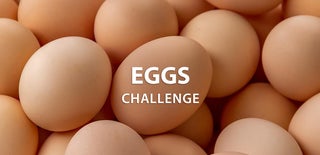Introduction: The Start-Here Tortilla
The tortilla, or Spanish omelette, is a staple of restaurants across Europe, and every Spanish family has their own recipe.
To me, though, it is both a tasty, filling meal and a really good way to use up spare ingredients that would otherwise go to waste, and the variations on the theme are almost limitless.
The recipe that follows is, as far as I am aware, the simplest possible version of a Spanish omelette, upon which you can build your own ideas.
(Please don't show this to any actual Spanish people you know, though, because they could get a little irate with the liberties I have taken.)
Supplies
At the very least, you need potatoes and eggs. In this version, I used six smallish potatoes and three medium eggs. The potatoes are part of a bag of "wonky" potatoes from the supermarket; 2.5kg knocked down to 25p (about 30c US) because they were close to their sell-by date*.
Purists expect an onion to be in there as well, but you can almost any vegetables you like, plus leftovers of cooked meats or cheese.
Salt and pepper help the flavour, and I like to add dried mixed herbs as well.
(*That was a week ago, and they're still absolutely fine!)
Step 1: Potatoes
Scrub and thickly-slice your potatoes. Don't bother peeling them unless they are really manky.
Boil for about ten minutes, or until they feel "right" when you poke a fork into a slice.
I don't know if they're a thing outside of the UK, but it's really easy to substitute in a tin of "baby new potatoes" here - skip the boiling, just jump straight to the frying-pan stage.
Step 2: Eggs
While the potatoes are boiling, crack your eggs into a mug, and beat with a fork. Add salt and black pepper to taste (about a big pinch of each). I also added about half a teaspoon of the dried mixed herbs at this stage.
Step 3: Frying
When the potatoes are boiled, lift the saucepan off the heat and replace it with a small frying pan (or omelette pan) to heat up with a dash of cooking oil, butter or margarine in it.
While the frying pan is heating up, which should only take a minute or two at most, drain the water off the potatoes, then tip them into the hot frying pan.
I like to fry the potatoes for a few minutes until they are a little crisp around the edges, but that is purely a matter of taste.
Step 4: Add the Eggs
Pour your beaten eggs all over the potatoes. With the heat of the potatoes and the pan, the eggs will start to cook immediately. You might need to tip and tilt the pan a bit to get all the potatoes covered, but you shouldn't need to stir.
Leave the pan to cook on a medium-high heat (on my hob, that's a 4 out of six) until the eggs are done. If you have a lid for your pan, that traps and reflects heat down onto the runnier eggs on top, and helps them cook.
When the eggs have just stopped being runny on top, and have lifted away from the pan around the edges, they're done. You can, if you wish, keep them on the heat for a couple more minutes to get the bottom nice and crispy, but you don't have to,
Step 5: Tip
Top tip: fill the eggy mug with water as quick as you can after pouring the eggs into the pan - dried raw egg is a pig to clean off things.
Step 6: Serve
That's it - the finished omelette should slide right out of a non-stick pan and onto your plate to make a very satisfying meal.
Alternatively, it makes a good meal for two if you also heat up a tin of beans and split it between you both.
Step 7: Experiment
As I said, this is a very simple base recipe to build on.
For a more traditional taste, dice a small onion and add them to the frying pan to brown a little before you add the potatoes.
Other good additions, include garlic, other cooked vegetables (carrots, runner beans etc), tinned veggies like carrots, sweetcorn or "diced mixed veg" raw leafy vegetables like spinach, or cooked meats like sliced & chopped ham, crispy-fried bacon or diced up hotdogs. Just about any leftovers can go into one of these. Keep your eye out in the supermarket for a bag of stir-fry veggies in the close-to-sell-by bargain-bin, they work really well. If you use frozen ingredients, they need thawed out before you add them to the mix - at least bring them to the boil in a pan of water first.
I'm told Spanish omelettes are nice if eaten cold the next day, but I've never been able to leave one alone long enough to find out...
As ever, I'd love to see what you make of this basic recipe. Maybe you could write up your own instructable...

Participated in the
Eggs Challenge













